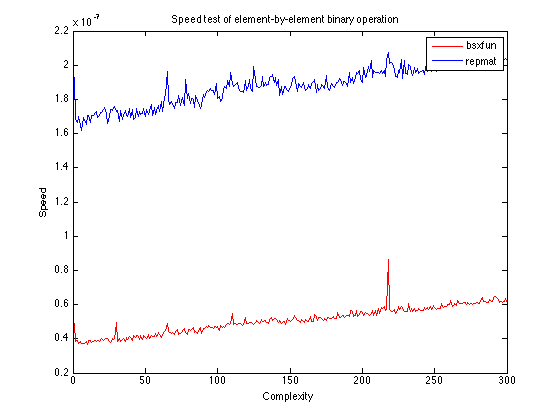bsxfun vs. repmat in Matlab
2014-04-16 23:48
281 查看
Documentation from Matlab:
bsxfun:
Apply element-by-element binary operation to two arrays withsingleton
expansion enabled.
repmat:
Replicate and tile an array.
Overview:
There are two approaches to apply element-by-element binary operation to two arrays with singleton expansion enabled, using bsxfun directly or applying repmat first and then make binary
operation.
Example:
>> a=rand(3,2)
a =
0.8721 0.3843
0.9016 0.0373
0.9518 0.9271
>> b=zeros(3,1)
b =
0
0
0
>> bsxfun(@minus,a,b)% operation
with singleton expansion enabled
ans =
0.8721 0.3843
0.9016 0.0373
0.9518 0.9271
>> a-b % operation with singleton expansion disabled
Error using -
Matrix dimensions must agree.
>> a-repmat(b,1,2)
ans =
0.8721 0.3843
0.9016 0.0373
0.9518 0.9271
Speed test:
Below is a speed test of the two approaches. Please find code at Appendix 1.

As shown in the graph, bsxfun is almost twice faster than repeat.
Why bsxfun is faster:
There are two reasons why bsxfun is faster than the other approach:
1. bsxfun avoids explicit allocation of memory and actual replication of the array;
2. bsxfun is one of the multi-threaded Matlab functions.
Furthermore...
Is it a good idea to replace normal (vars in same dimension) element-by-element operation with bsxfun?
Below is the result of my test. Please find test code in Appendix 2.

As shown in the graph, there is no need to replace normal element-by-element operation with bsxfun.
Appendix 1.
Comparison of bsxfun and repmat.
clear;
n = 300;
k = 1;
a = ones(10,1);
repmat_result = zeros(n,1);
bsxf_result = zeros(n,1);
num_repeat = 100;
tt = zeros(num_repeat,1);
for i = 1:n;
r = rand(1,i*k);
for it = 1:num_repeat;
tic,
x = bsxfun(@plus,a,r);
tt(it) = toc;
end;
bsxf_result(i) = mean(tt) / n;
for it = 1:num_repeat;
tic,
y = repmat(a,1,i*k)+repmat(r,10,1);
tt(it) = toc;
end;
repmat_result(i) = mean(tt) / n;
end
plot(bsxf_result,'-r')
hold
on
plot(repmat_result,'-b')
legend('bsxfun','repmat')
xlabel('Complexity')
ylabel('Speed')
title('Speed test of element-by-element binary operation')
Appendix 2.
Comparison of normal binary operation and bsxfun.
clear;
n = 300;
k = 1;
repmat_result = zeros(n,1);
bsxf_result = zeros(n,1);
num_repeat = 100;
tt = zeros(num_repeat,1);
for i = 1:n;
r = rand(k,i*k);
for it = 1:num_repeat;
tic,
x = bsxfun(@plus,r,r);
tt(it) = toc;
end;
bsxf_result(i) = mean(tt) / n;
for it = 1:num_repeat;
tic,
y = r+r;
tt(it) = toc;
end;
repmat_result(i) = mean(tt) / n;
end
plot(bsxf_result,'-r')
hold
on
plot(repmat_result,'-b')
legend('bsxfun','+')
xlabel('Complexity')
ylabel('Speed')
title('Speed test of element-by-element binary operation')
bsxfun:
Apply element-by-element binary operation to two arrays withsingleton
expansion enabled.
repmat:
Replicate and tile an array.
Overview:
There are two approaches to apply element-by-element binary operation to two arrays with singleton expansion enabled, using bsxfun directly or applying repmat first and then make binary
operation.
Example:
>> a=rand(3,2)
a =
0.8721 0.3843
0.9016 0.0373
0.9518 0.9271
>> b=zeros(3,1)
b =
0
0
0
>> bsxfun(@minus,a,b)% operation
with singleton expansion enabled
ans =
0.8721 0.3843
0.9016 0.0373
0.9518 0.9271
>> a-b % operation with singleton expansion disabled
Error using -
Matrix dimensions must agree.
>> a-repmat(b,1,2)
ans =
0.8721 0.3843
0.9016 0.0373
0.9518 0.9271
Speed test:
Below is a speed test of the two approaches. Please find code at Appendix 1.

As shown in the graph, bsxfun is almost twice faster than repeat.
Why bsxfun is faster:
There are two reasons why bsxfun is faster than the other approach:
1. bsxfun avoids explicit allocation of memory and actual replication of the array;
2. bsxfun is one of the multi-threaded Matlab functions.
Furthermore...
Is it a good idea to replace normal (vars in same dimension) element-by-element operation with bsxfun?
Below is the result of my test. Please find test code in Appendix 2.

As shown in the graph, there is no need to replace normal element-by-element operation with bsxfun.
Appendix 1.
Comparison of bsxfun and repmat.
clear;
n = 300;
k = 1;
a = ones(10,1);
repmat_result = zeros(n,1);
bsxf_result = zeros(n,1);
num_repeat = 100;
tt = zeros(num_repeat,1);
for i = 1:n;
r = rand(1,i*k);
for it = 1:num_repeat;
tic,
x = bsxfun(@plus,a,r);
tt(it) = toc;
end;
bsxf_result(i) = mean(tt) / n;
for it = 1:num_repeat;
tic,
y = repmat(a,1,i*k)+repmat(r,10,1);
tt(it) = toc;
end;
repmat_result(i) = mean(tt) / n;
end
plot(bsxf_result,'-r')
hold
on
plot(repmat_result,'-b')
legend('bsxfun','repmat')
xlabel('Complexity')
ylabel('Speed')
title('Speed test of element-by-element binary operation')
Appendix 2.
Comparison of normal binary operation and bsxfun.
clear;
n = 300;
k = 1;
repmat_result = zeros(n,1);
bsxf_result = zeros(n,1);
num_repeat = 100;
tt = zeros(num_repeat,1);
for i = 1:n;
r = rand(k,i*k);
for it = 1:num_repeat;
tic,
x = bsxfun(@plus,r,r);
tt(it) = toc;
end;
bsxf_result(i) = mean(tt) / n;
for it = 1:num_repeat;
tic,
y = r+r;
tt(it) = toc;
end;
repmat_result(i) = mean(tt) / n;
end
plot(bsxf_result,'-r')
hold
on
plot(repmat_result,'-b')
legend('bsxfun','+')
xlabel('Complexity')
ylabel('Speed')
title('Speed test of element-by-element binary operation')
相关文章推荐
- matlab如何读取未知行数,带头文件和字段名的txt文件
- matlab中的gallery函数简析
- Matlab 2014a 中包含BRISK算法
- Matlab绘制常见三维图形
- 用matlab绘制三维图
- matlab数组
- 基于Matlab的STM32软件快速…
- 基于Matlab的STM32软件快速…
- MATLAB 中NORM运用
- c++调用matlab求伪逆
- use regexp() to split a string
- matlab 的直方图均衡化
- c++中调用matlab引擎计算(亲测可用)
- [matlab] 矩阵操作
- c++ 调用matlab程序(亲测可用)
- Matlab S-function调试分享
- 如何关联m文件和Matlab编辑器
- Matlab:不包含边界和工具栏的figure(移除保存图片的白边)
- Matlab R2013b安装
- matlab中的bar, barh
